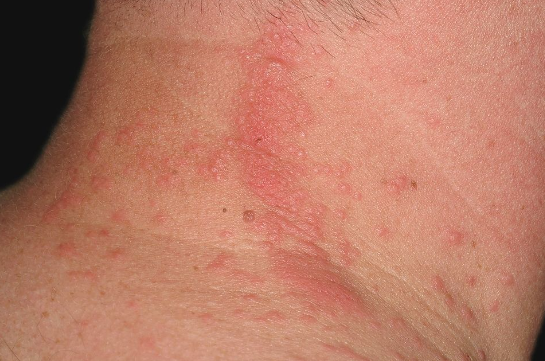Caterpillar dermatitis, also known as erucism, is an irritant or allergic contact dermatitis caused by skin contact with certain species of caterpillars. The ICD-10 code is L24.8.
The disease can occur at any age, regardless of gender or ethnicity, but is more common in children who play with caterpillars and in adult males in certain occupations, such as foresters, gardeners, farmers, and hunters. The disease can be caused by direct skin contact with certain types of hairy caterpillars (caterpillar dermatitis), inhalation of wind-borne caterpillar hairs (lepidopterism), or getting the hairs in the eyes (ophthalmologic papule).
Caterpillar hairs are hollow structures containing glandular epithelial cells that produce a toxin. The exact composition of the toxin is not fully understood, but some studies suggest that it contains peptides, hyaluronidase, phospholipase A, and biogenic amines such as histamine or histamine-releasing substances. When these caterpillar hairs come into contact with human skin, they penetrate, causing mechanical irritation, and when they break, they release the toxin. This toxin causes intercellular edema in the stratum corneum and diffuse vasodilation in dermis. In some patients, contact with caterpillar hairs results in the production of IgE antibodies, leading to hypersensitivity and the development of generalized urticaria on subsequent contact.
Caterpillar Dermatitis:
Dermatitis may occur either immediately or within 8-12 hours after contact with the caterpillar and presents as an intensely pruritic, painful, erythematous, papular, or urticarial rash, usually arranged in a linear pattern. In rarer, more severe cases, vesicles, bullae, petechiae, ecchymoses, and skin necrosis may be observed. The eruptions may persist for several days and then resolve spontaneously.
Systemic symptoms, which are not present in all cases, may occur within minutes of exposure (usually within 2 hours) and include headache, dizziness, restlessness, nausea, vomiting, malaise, tender and enlarged lymph nodes, muscle spasms, tachycardia, and, in rare cases, mental status changes. These symptoms usually resolve within 24 hours.
Persistent scratching due to severe itching may lead to secondary infection, manifesting as pustules, crusts, and occasionally furuncles and abscesses.
Lepidopterism:
Lepidopterism is characterized by acute rhinitis, lacrimation, cough, dyspnea, and chest pain. More severe cases may include headache, nausea, vomiting, bronchospasm, diffuse erythema, and urticaria.
Ophthalmologic papule:
The ophthalmologic papule develops when caterpillar hairs invade the cornea, anterior chamber, or lens of the eye and is characterized by acute conjunctivitis. In severe cases, keratitis, acute uveitis, retinochoroiditis, and endophthalmitis may occur, resulting in temporary or, in some cases, permanent blindness.
- Millipede Dermatitis
- Paederus Dermatitis
- Arthropod Bites
- Contact and Allergic Dermatitis
- Phytophotodermatitis
First Aid:
The caterpillar should be immediately removed from the skin (not by hand). The affected skin should be immediately washed with soap and water and dried without touching the skin (e.g., with a hair dryer or fan). If hairs get into the eyes, immediately flush the eyes with plenty of water or saline. Apply tape to the affected areas to remove the hairs. Other effective removal methods include the use of rubber cement, clear nail polish, or facial scrubs (each applied, dried, and then peeled off). Local cooling reduces pain (ice, isopropyl alcohol, or ammonia).
Treatment:
- Antihistamines (H1 and/or H2 blockers).
- Topical and systemic corticosteroids.
- Cyclooxygenase inhibitors (aspirin or indomethacin) to reduce discomfort, but their use should be avoided if signs of coagulopathy are present.
- Topical antipruritic agents containing menthol.
- If secondary infection occurs, topical or systemic antibiotics.
Treatment of Lepidopterism:
Antihistamines (H1 and/or H2 blockers) and beta-agonists as aerosols or inhalers. Oxygen inhalation and systemic steroids in severe cases.
Ophthalmologic treatment of papules:
Urgent consultation with an ophthalmologist for surgical papule removal.
Preventive measures:
All caterpillars should be considered potentially toxic and contact with them should be avoided, especially by children. When working outdoors during peak caterpillar breeding season, wear long-sleeved shirts, long pants with cuffs tucked into socks, and work gloves. Clothing collars should fit snugly. Wide-brimmed hats can prevent caterpillars from falling from trees onto your head and face. Use a tight-fitting face mask and goggles when working in areas with high caterpillar populations and strong winds. Extended clothing should not be hung outdoors to avoid exposure to airborne hairs. Insecticides may be used to control caterpillar populations.

